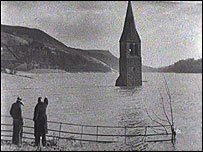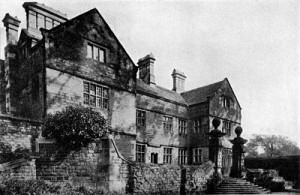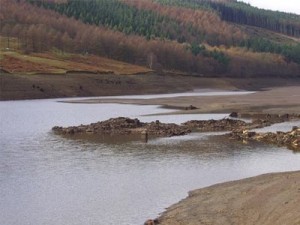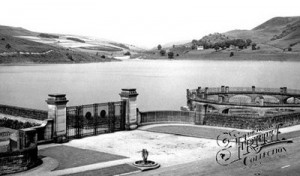by Charles Holland. Originally published on Fantastic Journal

This photograph is taken from a BBC film about Ladybower reservoir made in the 1960’s and on show here. The reservoir was formed in 1943 by flooding the Derwent Valley in Derbyshire, including the two villages of Derwent and Ashopton. The church spire of Derwent could be seen when the water level was low. Unfortunately it was later demolished destroying the fabulous surreality of it looming out of the water.
It’s a disquieting picture, an eerie combination of utilitarian infrastructure and apocalyptic imagery. It has the absurd quality of a fake, like those photographs of fairies and ghosts beloved of the Victorians. Perhaps it even is a fake, although the church tower was genuinely there.
A number of villages were flooded as a result of the need for water supply in cities likes Derby and Sheffield and Ladybower is one of three in the Derwent Valley alone. As a child I remember a story of one near the village where my parents lived when they were first married which had subsequently been drained leaving the remains of the village once more visible.
This process was like a 20th century version of emparking, the removal of unsightly villages by 18th century landowners as they sought to sculpt the countryside around their houses into three dimensional versions of classical paintings. The remains of these abandoned villages were co-opted into this vision as romantic grottos and ruined cottages.
At Ladybower though the reason behind these dramatic spatial transformations of landscape was ostensibly benevolent although its results were no less violent. Indeed, in a strange reversal of this history the stately home of Derwent Hall was also flooded. Its remains are still visible during low water levels so that it has become its own romantic ruin.


The resulting reservoirs are a hybrid of nature and machine, hugely impressive feats of engineering disguised as natural lakes, their water towers and viaducts rendered as medieval castles and Palladian bridges. The same surreal mix of futurism and picturesque fantasy that occurred in Victorian structures like Tower Bridge and in the science fiction fantasies of Jules Verne.
Looking at early photographs of the reservoir infrastructure, the elegant gates and stone balustrades are like the entrance to the landscaped garden of a stately home. But the home itself is no longer there and lies in fact in ruins on the water bed. The landscape and its villages has been dramatically reconfugured not as a result of the aesthetics of 18th century painting but the abstract dynamics of 20th water supply.

Picture above taken from the Francis Frith archive